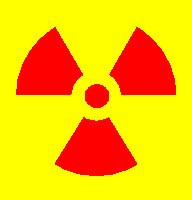

The basic, phenomenological fact of radioactive decay is that for
 particles at time t, the
number of these particles decaying in some small time interval
particles at time t, the
number of these particles decaying in some small time interval  is proportional to both the number
of particles present N, as well as the length of the time interval:
is proportional to both the number
of particles present N, as well as the length of the time interval:
The decay rate  is called the
activity, and since it is proportional to the number of particles present
(which decreases in time), it too decreases in time.
is called the
activity, and since it is proportional to the number of particles present
(which decreases in time), it too decreases in time.
As an approximation to reality, we take the limit of (4) for infinitesimally short time intervals

In this limit we get exponential decay - which we thus see is a good description on the average for a large number of particles, but clearly becomes very inaccurate as the number of particles gets small. This decay is ``spontaneous'', that is, it occurs without (and independent of) external stimulation. While the probability of decay decreases in time as the number of particles decrease, the actual decay is a random process in which the rate for any time period fluctuates, which leads to the typical sound of a Geiger counter.